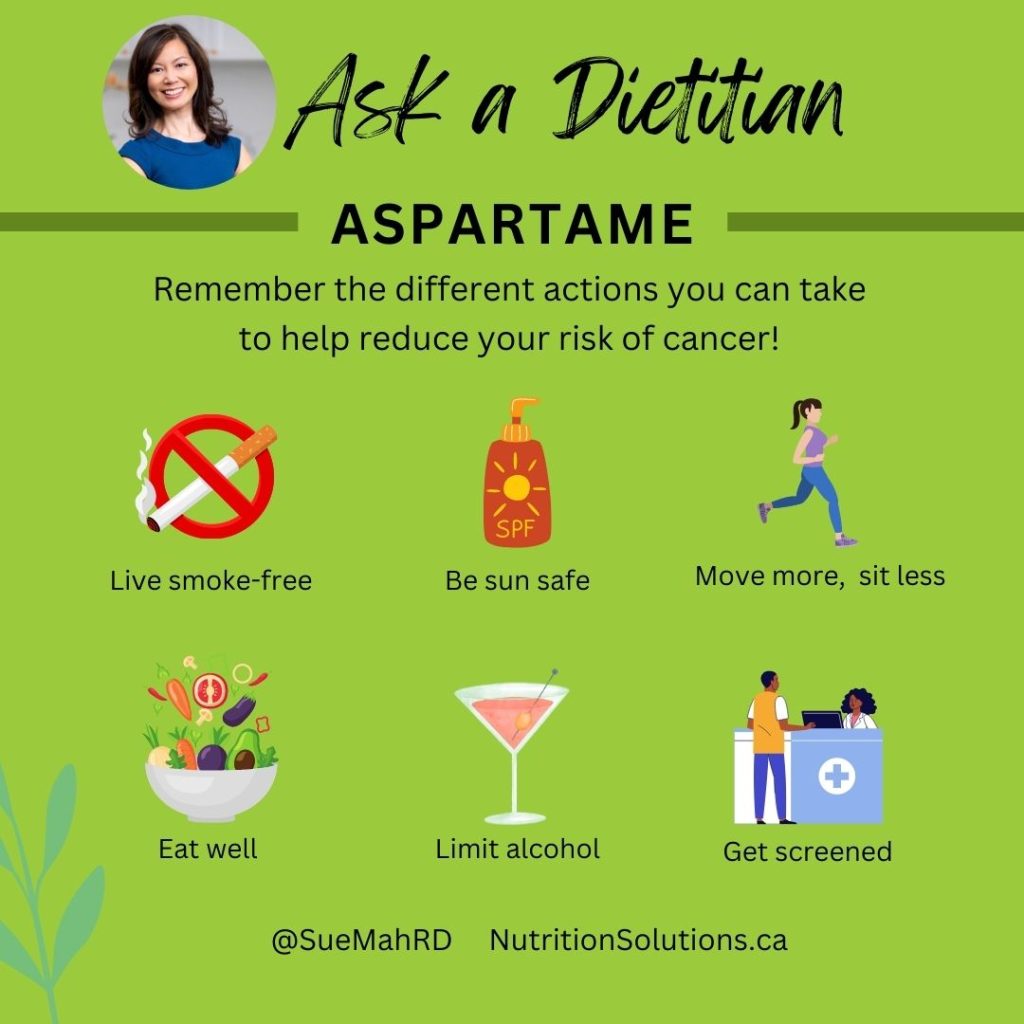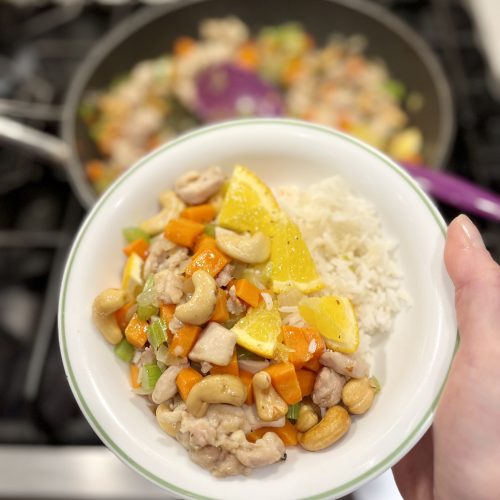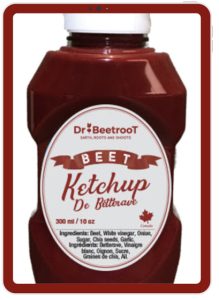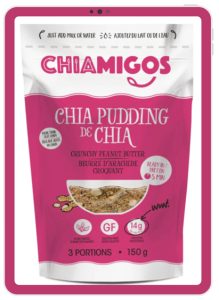
Aspartame is a low-calorie, artificial sweetener that is about 200 times sweeter than white sugar. It’s found in some diet soft drinks, desserts, yogurt, chewing gum and even some chewable vitamins. In Canada, aspartame has been approved for use as a food additive since 1981.
You may have seen recent news headlines about aspartame and cancer. Here’s what you need to know.
Two different groups did two different types of reviews
The health impacts of aspartame were assessed by two different organizations and they looked at two different things.
Review #1 by IARC – International Agency for Research on Cancer
The IARC conducted a HAZARD analysis. This type of review assesses the level of certainty that a substance can cause cancer. It does not consider dose or amount. Aspartame was classified as a Group 2B carcinogen, meaning that it is possibly carcinogenic with “limited evidence in humans and less than sufficient evidence in experimental animals.”
For background, substances classed in Group 1 are considered carcinogenic with “sufficient evidence in humans”, and those in Group 2A are considered probably carcinogenic with “limited evidence in humans and sufficient evidence in experimental animals.
Review #2 by JECFA – Joint Expert Committee on Food Additives (a joint working group of the World Health Organization and the Food & Agriculture Organization)
A second review of aspartame was undertaken by JECFA where they conducted a RISK analysis. This type of review assesses the exposure level or amount consumed that can pose a risk to health. They concluded that aspartame does not pose a safety risk in the amounts that people typically consume.
JECFA also confirmed that the Acceptable Daily Intake (ADI) of 40 mg aspartame per kg body weight is still appropriate. This is the same limit set by Health Canada. In USA, the limit is 50 mg aspartame per kg body weight per day.

What does 40 mg aspartame per kg body weight per day look like?
For a 70 kg adult, the Acceptable Daily Intake of aspartame would be 40 x 70 = 2,800 mg.
One standard can of diet soft drink contains between 200-300 mg of aspartame. In other words, you would need to consume 9-14 cans of diet soft drink in a day to reach the maximum limit of 2,800 mg of aspartame, assuming that you don’t get aspartame from other sources. This is the maximum amount of aspartame that can be consumed daily over a lifetime without presenting an appreciable risk to health.

Read labels carefully for aspartame
Currently, aspartame is listed on the food label along with the aspartame content per serving. However, Health Canada has just announced new food labelling regulations for aspartame and other sweeteners.
By January 1, 2026:
- Aspartame will no longer need to be listed on the front of packages.
- Aspartame will still appear in the ingredients list, but the amount of aspartame (in mg) per serving will no longer be shown.
- Foods sweetened with aspartame must still include a statement at the end of the ingredients list that warns individuals with phenylketonuria (PKU) that the food contains phenylalanine (this is a type of amino acid found in aspartame and needs to be avoided by people who have PKU).
See images below for a comparison of the original / current labelling of aspartame compared to the new labelling rules.


The Bottom Line
- Remember that the amount or dose of any substance is important when thinking about the risk to your health. According to the WHO and FAO, aspartame is safe in amounts that people typically consume.
- Look at all the products you consume which may contain aspartame such as diet drinks, sugar-free gum, dairy products and chewable vitamins. Stay within the Acceptable Daily Intake of 40 mg per kg body weight per day.
- Enjoy eating a variety of wholesome foods to lower your cancer risk: whole grains, nuts, seeds, vegetables, fruit and healthy fats.
- Take other healthy actions to lower your cancer risk: live smoke-free; be sun safe; move more and sit less; eat well; limit alcohol; and get screened for different types of cancer as recommended by your health care practitioner.

Follow me on Instagram @SueMahRD for weekly nutrition tips and recipes.

 On a recent trip to the grocery store, I noticed a brand of milk labelled as “high protein.” Compared to regular dairy milk, the high protein dairy milk contains 50% more protein and 50% less sugars. See the chart below for a quick nutritional comparison.
On a recent trip to the grocery store, I noticed a brand of milk labelled as “high protein.” Compared to regular dairy milk, the high protein dairy milk contains 50% more protein and 50% less sugars. See the chart below for a quick nutritional comparison. According to the company website (FairlifeCanada.ca), the high protein milk is made through an ultra-filtration process. No protein powders are added to the milk. Instead, the milk flows through multiple filters which concentrates the protein and calcium content while separating out the sugars (lactose). Most of the lactose is removed during this ultra-filtration. A lactase enzyme is then added to convert any remaining lactose into smaller, digestible sugars, resulting in a lactose-free milk with only 6 grams of sugars.
According to the company website (FairlifeCanada.ca), the high protein milk is made through an ultra-filtration process. No protein powders are added to the milk. Instead, the milk flows through multiple filters which concentrates the protein and calcium content while separating out the sugars (lactose). Most of the lactose is removed during this ultra-filtration. A lactase enzyme is then added to convert any remaining lactose into smaller, digestible sugars, resulting in a lactose-free milk with only 6 grams of sugars.





 Beets weren’t a big part of Anan Palanichamy’s diet growing up in India. But when the food processing engineer moved to Winnipeg Manitoba, he discovered their great taste and nutritional properties. The beet ketchup is made with beets grown in Portage la Prairie. Ingredients include beets, chia seeds and garlic. The sugar content of the beet ketchup is comparable to tomato ketchup, but is low sodium with only 5 mg per 1 tablespoon serving compared to about 150 mg in ketchup. The company also offers beet hummus, beet chips and beet chutney.
Beets weren’t a big part of Anan Palanichamy’s diet growing up in India. But when the food processing engineer moved to Winnipeg Manitoba, he discovered their great taste and nutritional properties. The beet ketchup is made with beets grown in Portage la Prairie. Ingredients include beets, chia seeds and garlic. The sugar content of the beet ketchup is comparable to tomato ketchup, but is low sodium with only 5 mg per 1 tablespoon serving compared to about 150 mg in ketchup. The company also offers beet hummus, beet chips and beet chutney.






